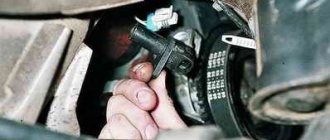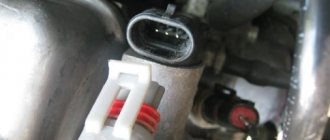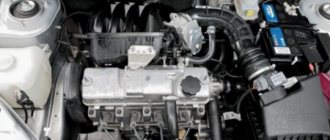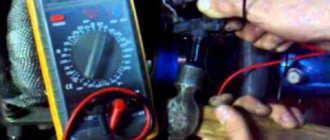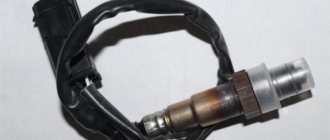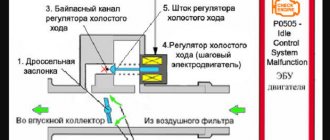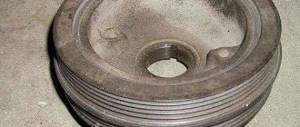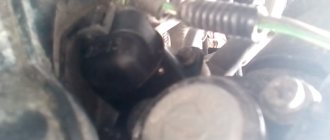First, let's look at what a crankshaft position sensor is. The crankshaft position sensor of the VAZ 2114, like many other VAZ models, is an electromagnetic device that transmits information about the position of the crankshaft to the electronic “brains” of engine control. This sensor is very important; the correct operation of the fuel injectors and the ignition system depends on it. It doesn't break down often. But if you are going on a long trip, it is advisable to have a spare one.
Crankshaft position sensor VAZ 2114
Sensor types
Sensors differ in operating principle and design features.
- inductive type. Inside there is a metal rod with a magnet at the outer end. It is designed to magnetize the rod. A winding of copper wire is wound around this rod, the ends of which are brought out in the form of connectors for connecting wires. The operating principle of the inductive type crankshaft position sensor: when a steel object is located next to the rod, a signal appears at the terminals.
- The operating principle of the next type of crankshaft sensor is slightly different. It has a hall sensor inside. When a metal object is brought close to it, its state changes (from logical zero to one and vice versa).
- frequency Let's look at how this type of crankshaft sensor works. The engine control unit generates pulses of a certain frequency. They are fed to the sensor and when a metal object is brought to the sensor, the generation frequency changes. By changing the frequency, the controller determines the presence of an object near the sensor. The sensor reacts to the metal of the crankshaft ring teeth (on some cars it is located on the flywheel).
CRANKSHAFT POSITION SENSOR (CPSE)
In short, the crankshaft position sensor (CPS) detects when each piston reaches top dead center (TDC). To calculate the timing of the spark, the ECU calculates the angular position of the crankshaft connecting rod relative to TDC. To illustrate this, the ECU can time the spark to occur 10° before top dead center (TDC) on the compression stroke. See Photo 1.
Photo 1
CKP also detects cylinder misfires in post-1996 OBD II engines by measuring very small variations in crankshaft speed. For example, the crankshaft slows down as the cylinder approaches TDC on the compression stroke. After combustion, the crankshaft accelerates on the drive stroke to approximately 90° after top dead center, when cylinder pressure is used up and the connecting rod angle is reduced. When this very predictable deceleration and acceleration pattern is continually disrupted, the ECU stores a misfire trouble code for that cylinder.
Symptoms of a problem
Signs of a malfunction of the DPKV can be different. Often, dirt adheres to the end of the sensor itself, which can interfere with reading. Also, symptoms of a faulty crankshaft sensor may be as follows:
- The idle mode is unstable;
- Engine speed rises or falls spontaneously;
- Power drops;
- During acceleration, a “failure” is felt;
- The car doesn't start well.
In these cases, for the most part, the VAZ 2114 crankshaft position sensor is replaced.
In addition, the VAZ 2114 crankshaft sensor may well be in good working order. And on the “tidy” the DPKV error will appear (0335 or 0336). The reason for this may be a broken wire near the connector. This is easily determined visually; then it is enough to replace the connector without replacing the sensor itself.
If the owner notices signs of a malfunction of the crankshaft sensor on his car, then this is a “signal” about the need for diagnostics.
It’s not difficult to guess where the crankshaft sensor is located on a VAZ 2114 . Like many other VAZ models, it is attached to the engine, and more specifically to the oil pump, near the generator drive pulley, on its cover. The sensor is attached with one bolt, which is typical for many models of this family.
Here is the crankshaft sensor on the VAZ 2114
Typical causes of failure:
- Physical damage to the case;
- The interturn closure of the winding turns entails a change in the generation frequency transmitted to the control unit (frequency type sensors);
- Emergency wear or loss of pulley teeth.
crankshaft sensor UMZ 4216 — search on DRIVE2
Comparison of phase sensors UMZ 4216, ZMZ 405,406 - GAZ Gazelle.
Hello guys, I'm boiling, I'm tired of changing sensors
phases... In short, due to the low cost, I always bought
sensors
, to be honest, a rare g...o. Over the past 3 months I have changed 5 pieces.
Sensors DPKV, DPRV(DF), DTOZH, DD. — GAZ 31, 2.9 l., 1997.
This post will talk about some sensors
installed on the motor itself.
About their necessity, installation features.
DPKV
-
crankshaft
position sensor . The
crankshaft
position sensor is designed to estimate the rotation speed
the
crankshaft .
Crankshaft position sensor GAZelle Business
Yesterday evening I started having problems starting. The warmed up engine started on the second or third attempt. There were no longer any options for repairs at 17:00 outside the city, so there was nothing left to do but finish the work and, if possible, move towards the house.
Waterproofing the crankshaft sensor? — GAZ Gazelle, 2.9 l., 2008.
Sensor
The crankshaft
position is flooded again! It's like a curse! Once even after washing
The ECU reports " sensor
crankshaft
position » And how many times did I get up in the spring or
I once went to Umz
so. So there, as if a drop gets on the spark plug caps, that’s it.
P0336 Crankshaft Position Sensor Error
1. Check the wires and resistance of the sensor
crankshaft position
.
_ Resistance may change slightly as temperature increases. 2. The output signal of the sensor
should have an AC voltage amplitude of about 0.
Symptom of a faulty crankshaft sensor
One of the most important components of a modern car is the DPKV sensor
crankshaft
position , signs of malfunction of which signal the driver about the need for urgent repair of this unit.
Repair of UMP – 4216…
Sigurdja › Blog › Repair of UMP
–
4216
… Sigurdja last online 2 weeks ago.
the sensor was installed in the upper radiator hose
turn on the fan and set
the sensor
to a temperature of 97°-82°. Connected.
Injecting 417th. (Part 2) - GAZ 21, 2.4 l., 1967
(By the way, I forgot to write about the sensor
coolant temperature (CLT).
DTOZh is needed for the brain, but with it, if you take the wire to the arrow (pointer on the dashboard) from a braid of wires, the arrow will not work correctly. Therefore, we need 2 sensors
, one for the brains.
Overhaul of UMZ 4216
The guy advised me to look at the sensors
, brains and something else, the issue with the correct installation of the ignition was swept aside, because...
The marks on the crankshaft
and camshaft gears were definitely set correctly.
The guys took the engine brains to check, everything was ok, they changed all the sensors
.
Read more: Ford Max fuel pump
Hooray! STARTED... and less than a year has passed! — KIA Sportage, 2.0 l., 2001.
Sensor
synchronization 35.3847 is designed to generate an electrical signal when the angular position of a special toothed disk mounted on the
engine
crankshaft .
The sensor
is used as part of a comprehensive engine control system.
How to check the Crankshaft Position Sensor (CPS)
Sensor
crankshaft position
- all about
the crankshaft
sensor It is very difficult to imagine a modern miracle of engineering - a car without an abundance of electronic systems.
Camshaft and crankshaft sensors ZMZ 406. - Community.
Good day everyone! If with sensors
temperatures and their manufacturers, everything is clear (except for the recommended 405226, there is nothing special to take), then with the above
sensors
I don’t know what to choose, the topic is not discussed, so I turn to the community.
Gazelle error 053. crankshaft position sensor malfunction
Good afternoon everyone. Tell me who is in the subject. Such an incident happened for two days in a row, I drove a gazelle 406 engine and had no complaints about the work. But on the third it didn’t start. When you turn the engine it catches periodically but refuses to work.
Report after updating the UMZ 4216 - GAZ software.
the UMZ
4216
software . saigak007 last online more than 1 month ago.
remove the terminal from the cable. from any sensor
.
...from the crankshaft camshaft
. Well, in short, there are a lot of them out there, choose which thread and find a good one.
DPKV from Gazelle - Great Wall Hover, 2.0 l., 2014
Let me start with the fact that I have
crankshaft
sensor .
In the summer I went to the seaside, took a sensor
and threw it into the Hover, thinking if I cut off some chips and twist them.
This is the only sensor
without which you can’t move. When ordering the variator, I ordered and.
Measure seven times (crankshaft position sensor) - UAZ 3160.
I decided to buy a new sensor
, try, and suddenly the long-standing glitch disappears, with a reluctance to start 5 minutes after turning off the warm engine, I’m already used to juggling the
crankshaft
position sensor , the only thing that helps.
Ignition system UMZ 4216
The electronic control unit receives reference signals from sensors
crankshaft position and
phases.
The UMZ
4216
ignition system is part of the engine control system and consists of an ignition coil, high-voltage wires, etc.
GAZ Gazelle UMZ 4216
Waterproofing
crankshaft
sensor ?
Colleague! Health to you and everything connected with you. I recently rode a Gazelle 3302 farmer 4x4 with a UMZ
4216
injector Euro 3 2012.
Question about the sensor on UMZ 4213; 4216 - Community "UAZ drivers".
I didn’t like UMZ
4216
or
UMZ
motor on
sensor
When will I get married ZMZ-40200M and ZMZ- 4216
and they will install it on the Volga to scribble over this problem.
In the 402, the crankshaft
do not fall out below the belly and therefore the block is more rigid.
We continue to assemble spare parts for UMZ 421. EvoTech camshaft - UAZ.
If the connecting rods and gears of the camshaft and crankshaft
can't be tuned, so here's the camshaft
Briefly from an article about the UMP
A274: “Usually a reduction in engine volume, all other things being equal
We need a camshaft for UMZ
4216
, we simply have nowhere to get normal spare parts.
Functionality check
If you decide to check the serviceability of the sensor yourself, treat this procedure responsibly and carry it out correctly. On a VAZ 2114 car, the crankshaft sensor is checked in several ways.
- Using a multimeter. The serviceability of the induction sensor can be assessed by the resistance of its coil. In a working product it is 500-700 Ohms.
- On the multimeter, set the measurement limit to 200 millivolts, connect the probes to the terminals (where the standard wires are connected). Pass a steel object several times in front of the core. The working sensor will “see” the metal and there will be voltage spikes on the multimeter display. If there are none, replace the part.
- But the most accurate results when checking are provided by an oscilloscope. When using this device, one hundred percent results can be guaranteed; it reads all the information from the sensor while the engine is running. It can be observed on the device screen. The engine, during tests, should operate at different speeds. They start with eight hundred revolutions, then two thousand, and raise it to six thousand. If the lines (on the device screen) are of different lengths, you need to look for the cause of the malfunction. Remove dirt, check the pulley for defects, and so on.
Oscillogram of a working sensor
Oscillogram of a working VAZ 2114 crankshaft sensor
It should be noted that these verification methods work on all VAZ models with DPKV. If you have any doubts about your own abilities, then contact the service. Thanks to specialized equipment, the result will be more accurate, and the check will not take much time.
Remove from the engine
The malfunction has been identified. Let's start eliminating it. Let's look at this operation using the VAZ 2114 as an example.
Turn off the car ignition. We open the hood, fix it firmly, and visually determine where the VAZ 2114 crankshaft sensor is located. Before removal, it is advisable to remove all contaminants in the area where it is located. Next, carefully remove the block with wires from the connector.
Connector DPKV VAZ 2114
Using a “10” wrench, unscrew the fastening bolt.
Removing the crankshaft sensor on a VAZ 2114
Let's take it out.
Removing the DPKV VAZ 2114
After dismantling the sensor, it is advisable to check the generator drive toothed pulley for defects. Since its damage can introduce errors into the operation of the entire system.
After we are convinced that there are no defects of any kind, we proceed to assembly. The seat must be clean. We install the new part in place and fasten it with a bolt (the tightening torque should not exceed 8-12 Newton meters). In this case we use adjusting washers. They are sold complete with a new sensor. Thus, using a special probe, we ensure that the gap between the pulley and the sensor core is one millimeter. The permissible error is 0.41 millimeters in the larger direction.
The gap between the pulley and the crankshaft sensor core on a VAZ 2114
We connect the block with wires into place.
After installation and checking the gap, we try to start the engine. With a confident start and stable operation of the engine, we can say that the repair was carried out successfully.
Despite the fact that the breakdown of the synchronizing sensor is not frequent, knowledge of its symptoms and consequences, as well as methods of elimination, will be useful to the car enthusiast.
New sensors are available in almost any auto parts store. The price of DPKV can vary between 200-400 rubles. How much a VAZ 2114 crankshaft sensor costs depends on your region, the location of large spare parts stores nearby (usually cheaper there) and the greed of the seller. Can be ordered in the online store. When purchasing, take the old one with you so as not to make a mistake in choosing a model. To avoid defects and repeated purchases, it is advisable to purchase from well-established sellers.
MAGNETIC CRANKSHAFT POSITION SENSORS
A magnetic resistance sensor is basically a single wire wrapped around a permanent magnet, with each end of the wire representing a positive or negative pole. When the rotating tooth of the iron reactor passes the sensor, it generates an alternating current (AC) signal to the ECU.
Oscillogram of the crankshaft sensor
In Photo 4 , notice that the "analog" signal varies between approximately 0.8 positive volts and 0.2 negative volts. Because AC voltage can be displayed more accurately in a laboratory setting than a voltmeter, it is easier to monitor the voltage as it alternates between positive and negative. In this case, the ECU “reads” the DPKV when the sensor signal crosses the zero voltage line. The accuracy of the resistance sensor varies slightly due to the voltage switching from positive to negative at slightly different points along the "zero" line. The accuracy of the resistance sensor can also be affected by the sensor magnet attracting ferrous metal particles from clutch linings or wear parts.
In most applications, the rotor of the number one cylinder is slightly modified to provide a "signature" waveform indicating to the ECU when that cylinder reaches DPCV. When diagnosing a reluctance sensor, it is very important to remember that the output voltage or amplitude is largely dependent on the air gap between the sensor tip and the reactor and the rotation speed of the reactor.
Sensor diagnostics
Before you begin diagnosing DPCV and DPPV circuits using a voltmeter or laboratory oscilloscope, try to understand how the system works by having the necessary wiring diagrams at hand. To illustrate, most DPCV circuits are connected directly to the ECU.
But, if ignition occurs through the ICM, the CKP is usually connected directly to the module. Some ICMs receive a digital signal from the Hall Effect DPKV sensor and transmit this signal to the ECU. Other ICMs convert the analog signal from the reactive type DPKV sensor into a digital signal before passing it to the ECU. Once the engine starts, the ECU advances the spark by modifying the DCCV signal and returns it to the ICM as an electronic spark timing signal.
Here's an interesting analog or sine wave signal I captured that includes a signature signal. See photo 7 . The EST signal sent from the ICM to the ECU is also bad. See Photo 8 .
It goes without saying that the DPCV signal from the reactor type sensor is well above zero volts, indicating that the ICM may have a poor ground. See photo 9 .
